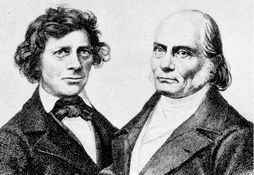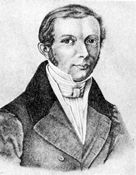

|
|
Clin. Cardiol. 23, 709–710 (2000)
This section edited by J. Willis Hurst, M.D., and W. Bruce Fye, M.D., M.A.
W. Bruce Fye, M.D., M.A.
Department of Cardiology, Marshfield Clinic, Marshfield, Wisconsin, USA
 |
 |
|
| Fig. 1 Ernst Heinrich Weber (1795–1878) (right) and Eduard Friedrich Wilhelm Weber (1806–1871) (left). From the collection of W. Bruce Fye. | Fig. 2 Wilhelm Eduard Weber (1804–1891). From the collection of W. Bruce Fye. |
This biographical essay is unique in the Profiles series because it describes the careers and contributions of three individuals. The brothers Ernst Heinrich Weber (June 24, 1795–January 26, 1878) (Fig. 1), Wilhelm Eduard Weber (October 24, 1804–June 23, 1891) (Fig. 2), and Eduard Friedrich Wilhelm Weber (March 6, 1806–May 18, 1871) (Fig. 1) are included herein because of their important research and publications dealing with hemodynamics and electrophysiology.1–4 They were born in Wittenberg, Germany (about 60 miles southwest of Berlin), into a family of 12 children. Ernst Weber, the oldest of the brothers, studied medicine at the Universities of Wittenberg and Leipzig. He spent his career at the University of Leipzig where his research and teaching focused initially on anatomy and comparative anatomy. Appointed to the Chair of Anatomy at the ancient university in 1821, Ernst also held the Chair of Physiology there beginning in 1840. When Carl Ludwig created his unique physiologic institute at Leipzig in 1865, Ernst gave up the Chair of Physiology and retired six years later.5 Wilhelm Weber received his medical degree from the University of Halle in 1826.6 Five years later he became a professor of physics at University of Göttingen, where he began a long and productive collaboration with the mathematician and physicist Carl Friedrich Gauss. In 1843, Wilhelm became a professor of physics at Leipzig, where his brothers Ernst and Eduard were already on the faculty. Eduard received his medical training at Halle and taught anatomy at Leipzig, where he became a full professor in 1847.
During the first half of the nineteenth century, physiology was transformed in France and Germany from a mainly observational and philosophical pursuit into an experimental science grounded in vivisection. The most influential pioneers of this new experimental physiology were François Magendie and Johannes Evangelista Purkinje.7 The Weber brothers began their academic careers in this fertile intellectual context. In 1821, Ernst launched a series of experiments on the physics of fluids. His younger brother Wilhelm, just 18 years old at the time, assisted him in these pioneering investigations. Their sophisticated research resulted in the publication in 1825 of Wellenlehre, auf Experimenten gegründet, a 575-page monograph on wave theory that included 18 copper plate illustrations. This classic book included the first detailed application of hydrodynamic principles to the study of the circulation of the blood.8
The Webers' book was recognized immediately as an important contribution to physics and physiology. It represented one of the earliest and most successful attempts to replace vitalistic physiology with an approach that employed principles from physics and mathematics. Recently, German historian and physiologist Carl Rothschuh described the Webers as pioneers of the what he termed the "physico-mathematical" approach to physiology. This new experimental model was more fully developed in Germany two decades later by Carl Ludwig, Herman von Helmholtz, Emil DuBois Reymond, and Ernst von Brücke. Rothschuh characterized the Webers' 1825 book as a work that "laid the groundwork for a more exact analysis of the undulatory movements occurring in fluids, especially when circulating through cylinders, the true basis for the motions of the blood."9 During the next quarter century, the Webers and other scientists extended these experiments on the dynamics of wave motion in fixed and elastic tubes.10
In 1827, Ernst described the effect of the elasticity of blood vessels in transforming the pulsatile movement of the blood in the aorta into a continuous flow of blood in arterioles and capillaries. Several decades earlier, Swiss physiologist Albrecht Haller had argued that each contraction of the heart caused the entire blood column to move forward en masse from the aortic valve to the capillaries, resulting in the pulse beating simultaneously throughout the body.11 Ernst showed, however, that the pulse wave traveled at 9.24 meters per second and arrived in the feet a fraction of a second after it reached the jaw. In a series of experiments over three decades, Ernst produced an ever-clearer picture of the role of elasticity and resistance in the vascular system as a determinant of the distribution and rate of flow of blood throughout the body. His pioneering research culminated in the publication of Ueber die Anwendung der Wellenlehre auf die Lehre vom Kreislauf des Blutes und insbesondere auf die Pulslehre in 1850.
The Weber brothers' second major contribution to physiology was their discovery of the phenomenon of vagal inhibition of the heartbeat.12 Ernst and Eduard's important experiments in electrophysiology began as a study of the physiology of muscle and were made possible by Michael Faraday's 1831 invention of the dynamo or electric generator. They connected one pole of an electromagnetic apparatus to the nostril of a frog and connected the other pole to the mid portion of the experimental animal's spinal cord. When they applied electric current, they noted dramatic slowing and sometimes frank standstill of the heart. Later, they extended their experiments from frogs to warm-blooded mammals such as cats, dogs, and rabbits. The Weber brothers first reported their observations at a scientific congress in Naples, Italy, in 1845 and published them in detail the following year.13
Physiologist and historian John Fulton translated the portion of their paper in which vagal inhibition was first described:
If the medulla oblongata of a frog or the ends of the isolated vagus nerves are excited by the rotation of a fairly strong electro-magnetic machine, the heart suddenly stops beating, but if the end of excitation begins after a short interval to beat again: at first slowly and weakly, then gradually more strongly and more frequently until finally the original beat observed before excitation is restored.
Fulton claimed that the Webers "deserve great credit for finally tracing the pathway of the effect which they observed to the vagus." He concluded that
...the experiment is a very important milestone in the history of physiology not merely because of its significance to the circulation, but because it brought to light a wholly new kind of nervous action and it formed the beginning of a series of highly significant researches upon the inhibitory processes occurring within the central nervous system.14
The diverse and important contributions of the Weber brothers extended well beyond their classic publications on hemodynamics and electrophysiology. They were influential teachers and mentors to two generations of scientists who continued to expand understanding of the structure and function of the human body and the physical and mathematical principles that governed many aspects of physiology.
Address for reprints:
W. Bruce Fye, M.D., M.A.
Mayo Clinic
200 First Street SW
Rochester, MN, USA
Received: October 18, 1999
Accepted: October 18, 1999